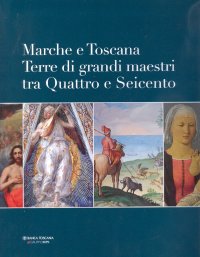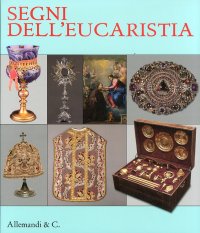Beato Angelico
Firenze, Palazzo Strozzi, September 26, 2025 - January 25, 2026.
Edited by Carl Brandon Strehlke.
Testi di Stefano Casciu, Marco Mozzo, Angelo Tartuferi.
Venezia, 2025; bound, pp. 456, 300 col. ill., cm 24x29.
cover price: € 80.00
|
Books included in the offer:
Beato Angelico
Firenze, Palazzo Strozzi, September 26, 2025 - January 25, 2026.
Edited by Carl Brandon Strehlke.
Testi di Stefano Casciu, Marco Mozzo, Angelo Tartuferi.
Venezia, 2025; bound, pp. 456, 300 col. ill., cm 24x29.
FREE (cover price: € 80.00)
Marche e Toscana. Terre di grandi maestri tra Quattro e Seicento
Ospedaletto, 2007; bound, pp. 320, col. ill., col. plates, cm 25,5x29.
FREE (cover price: € 77.00)
Segni dell'Eucarestia
Edited by M. Luisa Polichetti.
Ancona, Osimo, Loreto Jesi, Senigallia, Fabriano e Metelica, 23 giugno - 31 ottobre 2011.
Torino, 2011; paperback, pp. 221, b/w and col. ill., cm 24x28.
FREE (cover price: € 32.00)
Dizionario italiano e inglese di termini filatelici. Dictionary of english and italian philatelic terms
Dehn Roy A.
Vaccari s.r.l. - Filatelia, Editoria
Nuova Edizione 2004.
Vignola, 2004; paperback, pp. 96, cm 16,5x24.
(Gli Utili. 17).
series: Gli Utili.
ISBN: 88-85335-68-3 - EAN13: 9788885335684
Subject: Numismatics
Languages: 
Weight: 0.22 kg
The previous issue sold out some years ago; so we have decided, with the co-operation of the author, to print a new revised and corrected edition. The cover lay-out has been left quite the same; however, the presentation of data inside has been modified to make it even clearer.
For those who consult catalogues and philatelic literature in the original language, dealers or collectors, a useful dictionary specific for English and Italian philatelic terms now exists.
One part is devoted to the explanation of those terms, called "special", which do not have a direct translation into the other language and for which the meaning is given. There is also the translation of the colours, initials and abbreviations, most frequently used. Do not miss it!
FOREWORD A first edition of this dictionary appeared in the pages of Il nuovo Corriere Filatelico from April, 1977 to February, 1978. I wish to thank Vito Salierno, editor of that journal, for the help that he gave me. I am grateful to Franco Filanci for help with its original publication as a book.
Here now is a new edition, thanks to Bruno Crevato-Selvaggi's assistance, and to several readers' suggestions.
Some changes and additions have been effected to make the dictionary more usable. Two different sections, English-Italian and Italian-English, should make consultation easier. New words and new appendices should make the new edition more useful. However, the ideas and criteria remain unchanged.
The compiler of a technical glossary has to decide how much he can leave out. It is obvious that if he includes every word likely to be encountered in a philatelic text he will end up with a dictionary of the current written language. In choosing words for inclusion I have given emphasis to technical words and expressions, particularly those which concern printing, since these are often not included in ordinary dictionaries. A number of common words are included, however, because they are used in a special way in philatelic literature, for example the common word nuovo is included not only because it cannot be translated new in English, as would usually be possible in other contexts, but also because it is important to indicate significant qualifications such as con traccia di linguella (with trace of hinge).
Users of the dictionary should keep in mind the reasons for which apparently ordinary words have been included and realise that the translation given is a philatelic one. There is nothing to prevent a word being used in a philatelic text in a non-philatelic sense. This sense will not be indicated in the dictionary.
The word bold is included in the dictionary, but the meaning audace is not given; bold is included simply to indicate its use in phrases such as set in bold type (composto in neretto). Lap means grembo, but the word appears in the dictionary because it is used to describe a section of a postal journey or flight (tappa).
In the general dictionary an asterisk * has been placed after certain words as a warning that a word of similar appearance in the other language may not always have a similar meaning. For instance interi cannot be translated entires; these are something quite different.
Every now and then the student will find that in either one language or the other a word has to be used with special care because it may either have two sometimes contradictory meanings or because its normal and its technical meaning may conflict.
The words to describe privileged mail (lettere spedite in franchigia) provide an example. A frank can either be the signature of a person authorised to send mail free or the letter on which his frank appears; to frank or franking can either mean to authorise by signature the free despatch of mail or the application of postage stamps (affrancatura). In instances of this sort confusion can only be avoided by careful writing and on occasion the use of extra words e.g. free frank to describe the privileged letter sent post-free.
There are a number of technical expressions used in philatelic writing in English which cannot be translated because the equivalent procedures are not followed in Italy. The expression Key Plate and Duty Plate are examples. To help readers of texts using these expressions an appendix is provided giving explanations of the expressions as a substitute for translations which cannot be made.
Other appendices include a list of terms commonly used to divide the different fields of interest into general categories, a list of the definitive series which create more problems, and words and abbreviations used in philately or appearing in postmarks.
English and Italian place names are usually similar, but the few instances in which they are not can cause confusion as when, for instance, the tourist anxious to reach Montecarlo takes a train marked Monaco and finds himself landed in a city he has always called Munich. A short list of these confusing names is given.
The words for colours can easily be found in any bilingual dictionary. But a few paragraphs have been included to discuss the correct description of colours and to warn collectors of some of the dangers to be avoided in making translations.
Then come the adjectives used to classify philatelic items according to quality, and a selection of technical terms used in describing characteristics of printed letters. The use of the correct technical term, although by no means always the practice in either writing in English or Italian, can prevent misunderstanding and increase the clarity of information given.

Baia grande. La pialassa Baiona ultima frontiera per una valle salmastra










